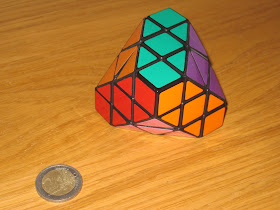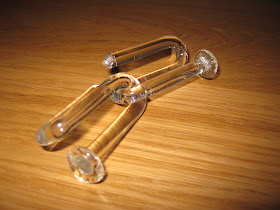A couple of weeks ago I was lucky enough to be able to make it to this years Dutch Cube Day (DCD) event! I was extremely happy to be going as it was to be the first international puzzle event that I have ever attended. A couple of the other
Midlands rabble managed to make it last year, and they came back with such good stories and pictures from the event that I just knew I had to make the trip out to the Netherlands this year.
It started with a 4am drive on the Saturday to pick up Ali (a fellow MPPer) and then we were straight off to Luton to catch the plane. I made the slight error of going to the cinema the night before, so to say I was a wee bit tired would be the understatement of the year. But still I was very excited for the day to come, and I think that easily carried me through the whole weekend!
Once myself and Ali had landed in Amsterdam we met up with
Allard, Chris, Nigel and Louis (even more fellow MPPers) at the airport. Allard Chris and Nigel had flown in from Birmingham just before us, and Louis caught the train from Eindhoven to meet us there. Louis has made the trip out to the Midlands many times now for our (very) regular MPPs, and it was nice to finally be able to make it out to the Netherlands to meet him there for a change. So many of us Midland lot made the trip out that we decided to combine DCD with the 8th MPP!
 |
| The Hotel Lobby |
We travelled from the airport to the hotel via train, which was only a short distance away. And as the hotel was right next to the train station, that made the travelling aspect of the trip very laid back. Although I dare to think where I would've ended up if Louis hadn't been there to direct us.
I took a photo of the hotel entrance. It's a terrible photo that doesn't really show anything, and I can only really blame tiredness for that. I kept forgetting to take photos as there was always so much going on, then I'd suddenly remember and start taking loads.....then forget again, and so on.
 |
| Off To The DCD Venue |
We stopped at the hotel for a while for everyone to settle in, then we met up in the restaurant for a bit of brunch. Right around this time Wil Strijbos and Christiaan Eggermont turned up and joined us for some food before we all headed off to the actual DCD venue to help Wil unpack his wares for the next day. This years event was going to be held at Sint-Maartenscollege in Voorburg, which as luck (or good planning) would have it was only a ten minute walk away from our hotel.
Only a couple of puzzlers had turned up today to set up their stalls for Sunday, including Wil and
Bernhard Schweitzer, and as well as helping to unpack we looked through the puzzles that would be available the next day and chatted with everyone there.
 |
| A Good Few IPP Exchange Puzzles |
After a few hours we all jumped into cars and cabs and made our way over to the home of Rob Hegge, who had kindly offered to entertain a group of unruly puzzlers for the afternoon.
Frans de Vreugd and
Simon Nightingale were already puzzling away on our arrival, and Rob made us feel very welcome with food and drink, although I think our attention was mostly taken up by his awesome puzzle collection!
 |
| An Incredible Puzzle Room |
Rob kept us thoroughly perplexed for most of the afternoon. Whenever one puzzle was solved (usually a puzzle box in my case) another one appeared shortly afterwards. He was very trusting and let us try any puzzle that was out on display in the cabinets, although I did try my best to make sure that puzzles went back into the cabinets in the same state that they came out.
I think all of us there managed to find a fair few puzzles that we've never solved or even seen before. I got completely stuck trying to solve the
Monkey's Palaquin puzzle box by Shiro Tajima, but happily managed to make my way through a good few other puzzles to make up for it. I have to admit that I spent most of my time working on the puzzle boxes because they are my favourite puzzle type, but there were so many other puzzles there that it was difficult to stick with one puzzle too long as there was always something else I wanted to look at next.
 |
| Out For Dinner |
After a few hours (probably...I completely lost track of time so have no idea how long we were there), we managed to pry ourselves away from Rob's place and travel en masse (there were eleven of us) to find somewhere nice to have dinner. We dropped our stuff back at the hotel and then proceed to wander the streets with Bernhard at the helm trying to find an Italian restaurant that he remembered. After a few backtracking manoeuvres we arrived at the restaurant and sat ourselves down for some good food, drinks and generally puzzling conversation. Wil would regularly pull a puzzle or perplexing object out of his bag and proceed to hand it around, which always managed to conjure up a fair few laughs. At one point Louis even tried to solve the restaurant wall! He did have a few drinks by this point, although none of them were alcoholic so I'm not sure what his excuse was.
After dinner we all toddled back to the hotel for a very overdue rest to get ourselves ready for the main event in the morning. Most of us hung around in the bar for a few more drinks before heading off to bed.
 |
| A Teeny Tiny Bit Puzzling |
A few of the guys headed off early the next morning to get to the DCD venue, but I went across an hour or so later with a few others who didn't fancy quite such an early start.
Upon arrival we signed in and picked up our name badges and the tiniest souvenir puzzle you could ever imagine. I love miniature puzzles, so this little 3D-printed creation by
Rich Gain was right up my street, and everyone else there seemed to really like them as well.
The pretty large main hall was full of puzzlers and their puzzles. Tables and tables of puzzles! I knew to expect quite a few people and puzzles to be there, but I was still surprised by the sheer amount and variety of them!
 |
| In The Main Hall |
We all split up and started wandering around the room. I kept seeing puzzles that I've been searching for all over the place! And occasionally they were even being sold by the designers themselves! It was great to finally be able to put faces to so many of the puzzlers I talk to regularly online and via emails. It really was a room of some of the nicest people you could ever hope to meet. A couple of them were even obliging enough to sign some of their own puzzle designs that I had bought that day.
 |
| Oskar And His Creations |
It was a real highlight to be able to meet
Oskar van Deventer for the first time, and have a play with some of his latest 3D-printed designs. He even brought along a copy of his infamous 17x17x17 cube, although I have a feeling that not too many people attempted a solve while they were there.
Another thing I was very much looking forward to was to picking up a long awaited puzzle from the incredible craftsman
Jack Krijnen. I'll write a bit more about that properly later on though as it is well deserving of its own review.
 |
| 17 x 17 x 17 |
Marcel Gillen has his own table there selling puzzles of all types, including some of his own hard to come by designs.
Tom van der Zanden was there showing some of his 3D-printed twisty puzzle designs, including his incredible
Multidodecahedron, which I was thrilled to finally see 'in the flesh'.
Goetz Schwandtner was there, and he brought along several
'N-ary' puzzles (that I really enjoy), including a design called Fidgety Rabbits by Namick Salakhov which was also an entrant in this years IPP Design Competition. I really loved this puzzle, and I made a mental note to track one down for myself eventually.
So many more puzzlers were met, and many many more puzzles were solved. I can't quite get pictures of them all into this post, but if you're interested in seeing the full set of pictures then visit
the DCD folder in my puzzle image gallery and you'll find them there.
 |
| Speedcubing Finals |
At the end of the event we stayed to watch the finals of the
Dutch Open speedcubing competition, where we got to see the European record being beaten for a 3x3x3 cube with an average time of just 7.66 seconds! After the event had finished we were all exhausted (and somewhat lighter in terms of our wallets), so we retired back to the hotel to pick up our bags ready to make our way back to the airport and then onto home.
It was a truly incredible weekend, and I can't express enough thanks to everyone there who made it as fun as it was. I met many new puzzlers, and saw many many new puzzles, and somehow a few of them managed to creep back home with me. It was really great fun, and I'm definitely looking forward to making the trip out again next year.
 |
| The Puzzles That Somehow Followed Me Home |



























.JPG)
.JPG)





















